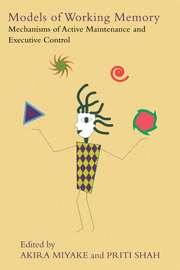Book contents
- Frontmatter
- Contents
- List of Contributors
- Dedication
- Preface
- Ode on Working Memory
- Acknowledgments
- 1 Models of Working Memory: An Introduction
- 2 Working Memory: The Multiple-Component Model
- 3 An Embedded-Processes Model of Working Memory
- 4 Individual Differences in Working Memory Capacity and What They Tell Us About Controlled Attention, General Fluid Intelligence, and Functions of the Prefrontal Cortex
- 5 Modeling Working Memory in a Unified Architecture: An ACT-R Perspective
- 6 Insights into Working Memory from the Perspective of the EPIC Architecture for Modeling Skilled Perceptual-Motor and Cognitive Human Performance
- 7 The Soar Cognitive Architecture and Human Working Memory
- 8 Long-Term Working Memory as an Alternative to Capacity Models of Working Memory in Everyday Skilled Performance
- 9 Interacting Cognitive Subsystems: Modeling Working Memory Phenomena Within a Multiprocessor Architecture
- 10 Working Memory in a Multilevel Hybrid Connectionist Control Architecture (CAP2)
- 11 A Biologically Based Computational Model of Working Memory
- 12 Models of Working Memory: Eight Questions and Some General Issues
- 13 Toward Unified Theories of Working Memory: Emerging General Consensus, Unresolved Theoretical Issues, and Future Research Directions
- Name Index
- Subject Index
2 - Working Memory: The Multiple-Component Model
Published online by Cambridge University Press: 05 June 2012
- Frontmatter
- Contents
- List of Contributors
- Dedication
- Preface
- Ode on Working Memory
- Acknowledgments
- 1 Models of Working Memory: An Introduction
- 2 Working Memory: The Multiple-Component Model
- 3 An Embedded-Processes Model of Working Memory
- 4 Individual Differences in Working Memory Capacity and What They Tell Us About Controlled Attention, General Fluid Intelligence, and Functions of the Prefrontal Cortex
- 5 Modeling Working Memory in a Unified Architecture: An ACT-R Perspective
- 6 Insights into Working Memory from the Perspective of the EPIC Architecture for Modeling Skilled Perceptual-Motor and Cognitive Human Performance
- 7 The Soar Cognitive Architecture and Human Working Memory
- 8 Long-Term Working Memory as an Alternative to Capacity Models of Working Memory in Everyday Skilled Performance
- 9 Interacting Cognitive Subsystems: Modeling Working Memory Phenomena Within a Multiprocessor Architecture
- 10 Working Memory in a Multilevel Hybrid Connectionist Control Architecture (CAP2)
- 11 A Biologically Based Computational Model of Working Memory
- 12 Models of Working Memory: Eight Questions and Some General Issues
- 13 Toward Unified Theories of Working Memory: Emerging General Consensus, Unresolved Theoretical Issues, and Future Research Directions
- Name Index
- Subject Index
Summary
FIVE CENTRAL FEATURES OF THE MODEL
(1) According to our view, working memory comprises multiple specialized components of cognition that allow humans to comprehend and mentally represent their immediate environment, to retain information about their immediate past experience, to support the acquisition of new knowledge, to solve problems, and to formulate, relate, and act on current goals.
(2) These specialized components include both a supervisory system (the central executive) and specialized temporary memory systems, including a phonologically based store (the phonological loop) and a visuospatial store (the visuospatial sketchpad).
(3) The two specialized, temporary memory systems are used to actively maintain memory traces that overlap with those involved in perception via rehearsal mechanisms involved in speech production for the phonological loop and, possibly, preparations for action or image generation for the visuospatial sketchpad.
(4) The central executive is involved in the control and regulation of the working memory system. It is considered to play various executive functions, such as coordinating the two slave systems, focusing and switching attention, and activating representations within longterm memory, but it is not involved in temporary storage. The central executive in principle may not be a unitary construct, and this issue is a main focus of current research within this framework.
(5) This model is derived empirically from studies of healthy adults and children and of brain-damaged individuals, using a range of experimental methodologies. The model offers a useful framework to account for a wide range of empirical findings on working memory.
Information
- Type
- Chapter
- Information
- Models of Working MemoryMechanisms of Active Maintenance and Executive Control, pp. 28 - 61Publisher: Cambridge University PressPrint publication year: 1999
Accessibility standard: Unknown
Why this information is here
This section outlines the accessibility features of this content - including support for screen readers, full keyboard navigation and high-contrast display options. This may not be relevant for you.Accessibility Information
- 650
- Cited by
